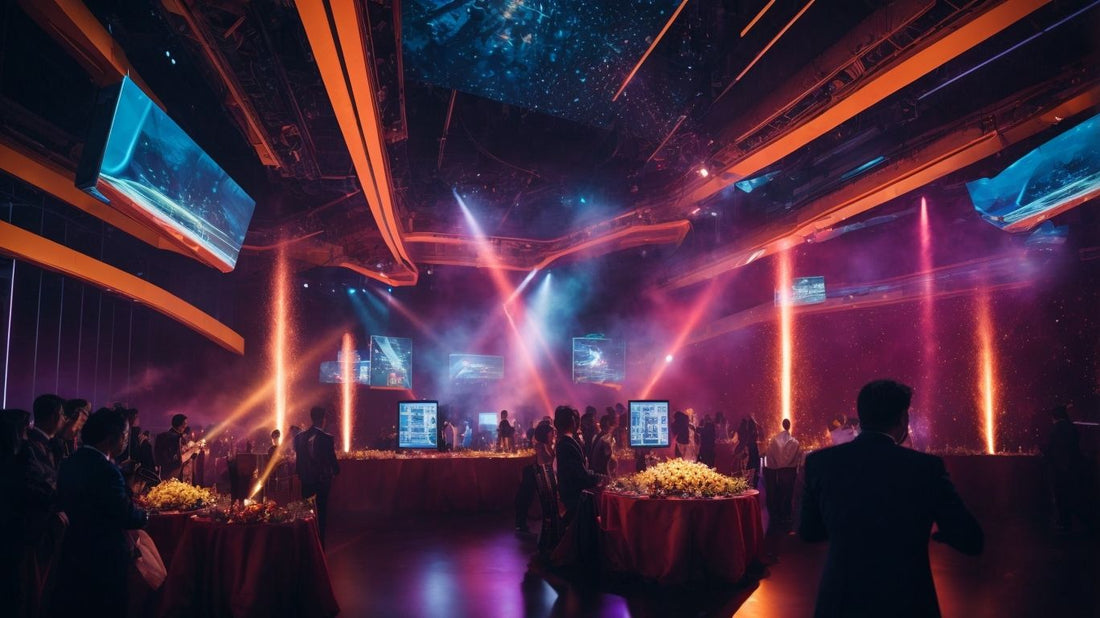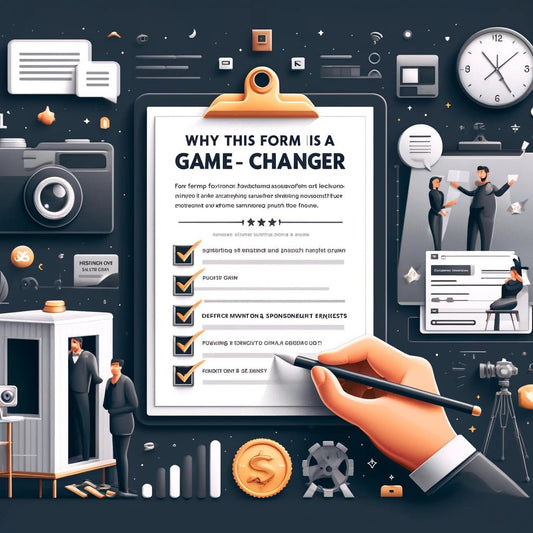
Top Corporate Event Trends: Stay Ahead with Latest Strategies
Share
.jpg)
Corporate events play a significant role in modern business strategies, serving as platforms for networking, brand building, and knowledge exchange. To stay relevant and maximize their impact, corporate events need to adapt to the ever-changing landscape. Several trends have emerged in recent years that are reshaping the corporate event industry.
Here are the current trends in corporate events that are shaping the way businesses plan and execute their events:
1. Virtual and Hybrid Events: The rise of technology has paved the way for virtual and hybrid events, allowing participants to attend from anywhere in the world through online platforms.
2. Sustainable and Eco-Friendly Events: Awareness of environmental issues has led to a growing emphasis on sustainable and eco-friendly event practices, promoting responsible event management and reducing waste.
3. Personalization and Customization: Attendees now expect personalized experiences, and event organizers are incorporating customizable elements to cater to individual preferences and create memorable experiences.
4. Technology Integration: Incorporating technology such as event management software, mobile apps, and interactive tools enhances engagement, streamlines logistics, and offers unique experiences.
5. Experiential and Immersive Experiences: Creating immersive and interactive experiences has become crucial to capture attendees' attention and leave a lasting impact.
6. Wellness and Wellbeing: Prioritizing the physical and mental wellbeing of attendees through wellness activities, mindfulness sessions, and health-focused initiatives is gaining traction in corporate events.
7. Interactive and Gamified Elements: Incorporating gamification and interactive elements into events boosts engagement, fosters networking, and adds an element of fun.
8. Social Responsibility and Philanthropy: Corporate events now often incorporate social responsibility initiatives and charitable components to contribute positively to the community.
Incorporating these trends into corporate events offers several benefits:
1. Enhanced Attendee Engagement: By embracing these trends, event organizers can create immersive and interactive experiences that keep attendees engaged and captivated throughout the event.
2. Improved Brand Image and Perception: Following the latest trends showcases a company's innovative and forward-thinking approach, enhancing its reputation and brand image.
3. Increased Networking and Relationship Building: Interactive and personalized elements enable attendees to connect and network more effectively, leading to meaningful relationships and collaborations.
4. Higher ROI and Cost Efficiency: Incorporating technology and sustainable practices can result in cost savings and increased return on investment by streamlining processes and reducing wastage.
Implementing corporate event trends requires careful consideration of factors such as budget, event goals, audience preferences, and logistics. By staying informed about emerging trends and aligning them with the objectives of the event, businesses can create successful and impactful corporate events in today's dynamic business landscape.
Current Trends in Corporate Events
Step into the exciting world of corporate events and discover the latest trends that are shaping the industry today. From virtual and hybrid events that redefine the concept of connectivity to sustainable and eco-friendly initiatives that prioritize the planet, this section will take you on a journey through the cutting-edge practices. Get ready to explore the realm of personalization and customization, witness the seamless integration of technology, embrace immersive experiences, prioritize wellness and wellbeing, engage in interactive and gamified elements, and emphasize social responsibility and philanthropy. It's time to dive into the dynamic landscape of current corporate event trends.Virtual and Hybrid Events
Virtual and hybrid events have experienced a surge in popularity in recent years, as they offer a multitude of advantages for both event organizers and participants. When planning such events, it is important to consider the following key factors:
- Technology requirements: It is crucial to ensure that all attendees have access to the necessary technology and reliable internet connections.
- Engagement strategies: To keep participants engaged, it is beneficial to incorporate interactive elements like live polls, Q&A sessions, and virtual networking opportunities.
- Content delivery: The delivery of high-quality content can be achieved through live streaming, on-demand recordings, or a combination of both.
- Accessibility: To cater to a wider audience, it is important to provide closed captioning, sign language interpreters, and accommodate different time zones.
Consider embracing virtual and hybrid event formats to expand your reach, enhance attendee engagement, and adapt seamlessly to changing circumstances.
Sustainable and Eco-Friendly Events
Sustainable and Eco-Friendly Events are becoming increasingly popular as companies strive to reduce their environmental impact and promote sustainability. Here are some key considerations for organizing such events:
- Green Venues: Choose venues that prioritize sustainability, such as LEED-certified buildings or those that have renewable energy sources.
- Reducing Waste: Implement recycling programs, use biodegradable or compostable materials, and encourage attendees to bring reusable water bottles and utensils.
- Sustainable Transportation: Encourage attendees to use public transportation, carpool, or provide shuttle services to reduce carbon emissions.
- Food and Beverage: Opt for locally sourced, organic, and seasonal food options that minimize the carbon footprint and support local businesses.
- Eco-Friendly Giveaways: Provide sustainable and useful giveaways like reusable tote bags, stainless steel straws, or seed paper products.
- Carbon Offsetting: Calculate the event's carbon footprint and invest in carbon offset projects to neutralize the emissions.
Personalization and Customization
The sub-topic "Personalization and Customization" is an important trend in corporate events. It allows event organizers to tailor experiences to meet the specific needs and preferences of attendees. Here are some ways to incorporate personalization and customization in your events:
Customize registration and ticketing processes to gather information about attendees' interests and preferences.
Create personalized agendas or schedules for attendees, allowing them to choose sessions or activities that align with their professional goals or interests.
Offer personalized recommendations or suggestions for networking opportunities based on attendees' profiles and preferences.
Provide customizable food and beverage options to accommodate dietary restrictions or preferences.
Use technology to personalize communication and engagement with attendees, such as sending personalized event updates or surveys.
By embracing personalization and customization, corporate events can create a more memorable and engaging experience for attendees, ultimately leading to greater satisfaction and success.
Technology Integration
The incorporation of technology is an essential aspect of modern corporate events. It plays a vital role in enhancing attendee experiences, streamlining event management, and improving overall productivity. Here are some natural ways technology is integrated into corporate events:
- Virtual Platforms: The integration of technology allows for the utilization of virtual platforms, enabling remote participation and expanding reach and engagement.
- Event Apps: Customized event apps provide attendees with personalized schedules, real-time updates, and networking opportunities, showcasing effective technology integration.
- RFID Technology: Technology integration includes the use of RFID badges, which enable seamless check-ins, tracking of attendance, and targeted communication throughout the event.
- Live Streaming: Technology integration in corporate events involves broadcasting event sessions or keynotes online, enabling a wider audience to participate and engage.
- Interactive Tools: Incorporating live polling, Q&A sessions, and gamified elements through event technology encourages attendee participation, highlighting the importance of technology integration.
Fact: According to EventMB, 62% of event professionals believe that technology integration is the key to boosting attendee engagement.
Experiential and Immersive Experiences
Experiential and immersive experiences have become a popular trend in corporate events, offering attendees a memorable and engaging experience. Here are some ways to incorporate this trend:
- Create interactive installations or exhibits that allow participants to actively engage with the content.
- Use virtual or augmented reality technology to transport attendees into virtual worlds or simulate real-life scenarios.
- Organize workshops or hands-on activities that enable participants to learn and explore new skills or concepts.
- Curate themed environments with atmospheric lighting, sound effects, and decor to create an immersive atmosphere.
- Integrate gamified elements such as team challenges or competitions to foster friendly competition and collaboration.
Wellness and Wellbeing
Incorporating wellness and wellbeing into corporate events has become an important trend. Attendees are increasingly looking for events that prioritize their mental and physical health. To create a wellness-focused event, consider the following:
- Offer healthy and nutritious food options to support attendees' well-being.
- Incorporate wellness activities like yoga sessions or mindfulness workshops.
- Create designated relaxation zones where attendees can take breaks and recharge.
- Provide opportunities for physical activity, such as group fitness classes or walking tours.
- Offer wellness-oriented gift bags with items like essential oils or stress-relief products.
True story: At a recent conference, the organizers introduced a wellness lounge with massage chairs, healthy snacks, and meditation sessions. Attendees appreciated the opportunity to relax and focus on their well-being, resulting in improved engagement and satisfaction levels.
Interactive and Gamified Elements
Choosing interactive and gamified elements in corporate events can greatly enhance attendee engagement and make the event more memorable. Here are some ideas to incorporate these elements:
- Interactive games and quizzes: Incorporate interactive games and quizzes that encourage attendee participation and engagement.
- Virtual reality (VR) experiences: Provide immersive VR experiences that allow attendees to interact with the event content in a unique and engaging way.
- Gamification challenges: Implement fun and interactive challenges or competitions that motivate attendees to interact with each other and the event content.
- Live polling and surveys: Utilize real-time polling and surveys to collect feedback from attendees and actively involve them in the event.
- Social media integration: Create interactive social media walls or contests, urging attendees to share their experiences and actively engage with the event online.
By incorporating these interactive and gamified elements, corporate events can provide a more engaging and memorable experience for attendees.
Social Responsibility and Philanthropy
Incorporating social responsibility and philanthropy into corporate events is an essential trend to consider. It not only aligns businesses with social causes but also enhances brand image and perception. Companies can organize events that support charitable organizations or promote sustainable practices, embodying the values of social responsibility and philanthropy. By integrating these principles into events, businesses can contribute to society while fostering goodwill among attendees. This trend reflects the increasing importance of corporate social responsibility and demonstrates a strong commitment to making a positive impact. By incorporating social responsibility and philanthropy into their events, companies can create meaningful experiences that resonate with attendees.
The Benefits of Incorporating These Trends
Discover the numerous advantages of incorporating the latest corporate event trends. From enhancing attendee engagement to improving brand image and perception, and from increasing networking and relationship building opportunities to achieving higher ROI and cost efficiency, these trends offer a wealth of benefits. Uncover the power of these trends and how they can elevate the success of your next corporate event.Enhanced Attendee Engagement
Enhanced attendee engagement is a crucial consideration when incorporating corporate event trends. Achieving this involves implementing various strategies:
- Interactive Sessions: To foster active engagement, it is essential to incorporate interactive elements such as live polls, Q&A sessions, and audience participation activities.
- Networking Opportunities: To facilitate connections among attendees, dedicated networking sessions, matchmaking platforms, or virtual chat rooms should be provided.
- Personalization: Enhancing the event experience can be achieved by offering personalized agendas, tailored content, and targeted networking suggestions based on attendees' interests and preferences.
- Gamification: Introducing gamified elements like contests, challenges, or leaderboard rankings can make the event more engaging and competitive.
- Multi-Channel Communication: To engage attendees before, during, and after the event, it is important to utilize various communication channels such as social media, event apps, and live streaming platforms.
Improved Brand Image and Perception
Achieving improved brand image and perception is crucial for the success of corporate events. Here are some key considerations to accomplish this:
- Elevate Visual Identity: Implement consistent branding elements throughout all event materials, including logos, colors, and fonts.
- Engage Influencers: Collaborate with industry influencers to effectively promote the event and enhance the credibility of your brand.
- Deliver Exceptional Experiences: Make the event memorable by incorporating unique activities, interactive displays, and personalized touches.
- Showcase Corporate Social Responsibility: Demonstrate your values and commitment to social issues through sustainable practices and philanthropic initiatives.
- Nurture Relationships: Create opportunities for networking, fostering connections among attendees and fostering a sense of community.
- Capture and Share Highlights: Take advantage of social media and other channels to share event highlights, testimonials, and positive experiences.
Increased Networking and Relationship Building
Increased networking and relationship building at corporate events can greatly benefit businesses and individuals. Here are some ways to facilitate this:
|
Networking and building relationships play a pivotal role in corporate events as they can significantly enhance the productivity and growth of businesses and individuals. To maximize the benefits, consider the following strategies:
|
Higher ROI and Cost Efficiency
To achieve higher ROI and cost efficiency in corporate events, it is important to implement the following strategies:
- Plan in advance: Early planning allows for negotiation and securing cost-effective options that can contribute to higher ROI and cost efficiency.
- Streamline resources: Optimize the use of staff, technology, and equipment to minimize costs, thereby enhancing ROI and cost efficiency.
- Utilize technology: Leverage event management software, virtual platforms, and automation to reduce expenses and improve efficiency, resulting in higher ROI and cost efficiency.
- Partner with sponsors: Collaborate with sponsors to offset costs and increase revenue through brand partnerships and sponsorships, ultimately leading to higher ROI and cost efficiency.
- Focus on attendee satisfaction: By providing a valuable and engaging experience, you can maximize the return on investment from each attendee, resulting in higher ROI and cost efficiency.
- Evaluate and measure: Analyze event metrics and feedback to identify areas of improvement and allocate resources effectively, contributing to higher ROI and cost efficiency.
Considerations for Implementing Corporate Event Trends
When it comes to implementing corporate event trends, there are several key considerations to keep in mind. From budget and resources to event goals and objectives, audience preferences and demographics, and venue and logistics, each sub-section plays a crucial role in creating a successful event. By understanding and addressing these aspects, companies can stay competitive, attract the right attendees, and deliver an unforgettable experience. So, let's dive into the essential factors that shape corporate event trends and ensure a seamless execution for maximum impact.Budget and Resources
When considering budget and resources for corporate events, it is important to carefully plan and allocate your resources to ensure a successful and cost-effective event. Here are some factors to consider:
- Establish a clear budget: Determine how much you can allocate for the event, including expenses for venue, catering, speakers, and marketing.
- Prioritize budget items: Identify the key areas where you need to allocate a larger portion of your budget, such as venue and entertainment, while minimizing costs in other areas.
- Seek sponsorship opportunities: Explore partnerships with sponsors who can provide financial support, venue facilities, or in-kind donations, reducing your expenses.
- Evaluate in-house resources: Assess if there are internal resources, such as staff or equipment, that can be utilized instead of outsourcing, saving on external costs.
- Consider cost-saving measures: Look for opportunities to reduce expenses, such as negotiating with vendors for discounts, utilizing technology for virtual aspects, or opting for more affordable alternatives.
By carefully managing your budget and resources, you can maximize the impact of your corporate event while staying within your financial parameters.
Event Goals and Objectives
When planning corporate events, setting clear and specific goals and objectives is crucial for achieving Event Goals and Objectives and ensuring a successful outcome. Event goals and objectives provide a roadmap for planning, execution, and evaluation, effectively guiding the entire process. They help determine the purpose of the event, whether it's to launch a new product, build brand awareness, or foster client relationships. By clearly defining these Event Goals and Objectives, event organizers can tailor every aspect of the event to align with the desired outcomes. This includes selecting appropriate venues, designing engaging activities, and measuring success based on predefined metrics. Ultimately, these well-defined Event Goals and Objectives ensure that the event delivers the intended results and maximizes the return on investment.
Audience Preferences and Demographics
Understanding audience preferences and demographics is crucial when planning corporate events. By tailoring the event to the specific needs and interests of attendees, organizers can create a more engaging and personalized experience.
| Preferences | Demographics |
| 1. Entertainment | 1. Age |
| 2. Networking Opportunities | 2. Gender |
| 3. Educational Content | 3. Occupation |
| 4. Food and Beverage | 4. Geographic Location |
| 5. Technology Integration | 5. Cultural Background |
By considering these factors, event planners can tailor their programming, activities, and offerings to match the preferences and demographics of their target audience, ensuring a more successful and impactful corporate event.
Understanding audience preferences and demographics is crucial when planning corporate events. By tailoring the event to the specific needs and interests of attendees, organizers can create a more engaging and personalized experience. When considering audience preferences and demographics, event planners can analyze factors such as entertainment, networking opportunities, educational content, food and beverage preferences, and technology integration. Additionally, demographic factors like age, gender, occupation, geographic location, and cultural background should be taken into account. By incorporating these elements, event planners can tailor their programming, activities, and offerings accordingly, ensuring a more successful and impactful corporate event.
Venue and Logistics
When it comes to planning corporate events, the venue and logistics are two crucial aspects that need to be carefully considered. These factors play a significant role in creating a successful and seamless experience for all attendees. Here are some key considerations to keep in mind:
- Location: When selecting a venue, it is important to choose one that is easily accessible for attendees and has good transportation links. This ensures convenience for everyone.
- Capacity: It is essential to ensure that the chosen venue can comfortably accommodate the expected number of attendees. Nobody likes a crowded event!
- Layout: The layout of the venue should be considered as it can greatly impact the flow of activities and networking opportunities. A well-designed space can enhance interaction and engagement among attendees.
- Amenities: Checking if the venue has necessary amenities such as parking, Wi-Fi, and audio-visual equipment is crucial. These amenities contribute to the overall comfort and functionality of the event.
- Catering: Exploring catering options that can accommodate any dietary restrictions or preferences is important. Providing diverse and delicious food options enhances the overall attendee experience.
- Logistics: Planning the logistics for transportation, accommodation, and acquiring any necessary permits or licenses is essential. It ensures a smooth and organized event for all.
- Accessibility: Ensuring that the venue is accessible for individuals with disabilities is of utmost importance. Everyone should be able to fully participate and enjoy the event.
- Budget: Considering the cost of the venue and logistics in relation to the overall event budget is necessary. It is important to allocate funds wisely to create a memorable event without overspending.
By carefully considering these venue and logistics factors, you can create a seamless and memorable corporate event experience for all attendees.






